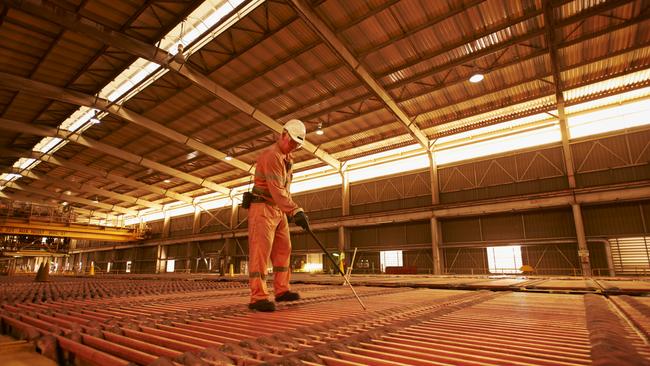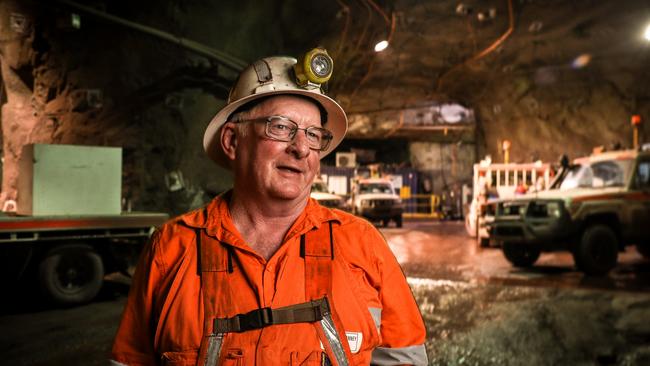BHP’s ‘School of Rock’ has been launched at Olympic Dam to ensure the mega-mine has the skills needed for the decades ahead
Jack Black was nowhere in sight, but BHP’s School of Rock attracted some big names to its launch today.
Baristas, barbers and school teachers are among the first graduates of a new “School of Rock” launched by BHP to ensure it has the skills needed for the future.
Officially known as the Underground School of Excellence, the new school, based at Olympic Dam — one of the largest polymetallic ore bodies in the world, situated in SA’s Far North — helps people get a flying start to their mining career.
“Through a tailored five-week program of theory and practical training, new starters are given the skills, language, and confidence needed make a safe and productive start to a mining career,’’ BHP said.
“The School of Rock also includes modules on BHP’s history, company purpose, working culture, and mental health.’’
Olympic Dam Asset President Laura Tyler said the School was an example of how BHP was helping build SA’s skills base “and providing new opportunities for people from diverse backgrounds to join our team.
“It is also a fantastic example of putting people first; of collaboration, ingenuity and
innovation that puts people and their wellbeing at the centre of what we do.”
Over the past six months, 87 people have been through the school, with positive results, BHP said.
“The injury rate for new starters is significantly lower than the mine average and retention rates are also increasing,’’ the company said.

BHP has been expanding the Olympic Dam mine in recent years into the Southern Mine Area, and is examining further growth programs.
These include a proposed, staged $3 billion expansion to 350,000 tonnes of copper per annum, up from about 200,000.
This expansion was this year granted major project status by the State Government.
Ms Tyler said it was an exciting time in the mine’s history.
“We are investing strategically in infrastructure and technology, and developing our underground mine to ensure we continue to create shared value for South Australians for decades to come,” Ms Tyler said.
premier Steven Marshall, who toured the mine this morning, commended BHP on the School of Rock program.
“BHP’s commitment to expanding the pool of workers that mining operations in South Australia can draw upon dovetails neatly with the State Government’s investment in 20,000 new work-based apprenticeships and traineeships,” he said.
“The School of Rock helps deliver on a responsibility employers and governments share to ensure we are training the next generation of employees for the jobs of the future.”

Josephine Breede, 22, was previously in client services at Adelaide Airport.
While none of her immediate family were in the mining sector, she said it was “something I constantly heard about.”
“I thought I’d give it a try and it’s the best thing I’ve ever done.”
Ms Breede, who has graduated from the School of Rock, now drives a concrete truck underground, delivering shotcrete to where it is used.
Lisa Wing, 26, was formerly a barista in the Barossa Valley.
While the only coffee underground is Nescafé Blend 43 — meaning her latte skills are currently under-utilised — she says the ability to develop news skills has been rewarding.
Ms Wing said a friend encouraged her to apply at BHP, which initially seemed a “crazy” idea.
“I’d never thought about it ever, but it’s been great.”
She’s now working in mine services, ensuring utilities such as water and electricity supply are installed and maintained.
BY THE NUMBERS
— Olympic Dam is located north northwest of Adelaide and is one of the world’s most
significant deposits of copper, uranium, gold and silver.
— The mine employs about 4000 people in South Australia, including 69 apprentices studying their first trade, and a further 41 studying their second trade. At present, Olympic Dam has about 250 open roles.
— In FY19, Olympic Dam spent nearly $130 million with local South Australian businesses, an increase of 20 per cent from the previous financial year.
— Olympic Dam has contributed tens of billions of dollars in investment, taxes, and royalties to South Australia over the past 30 years.

